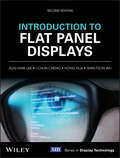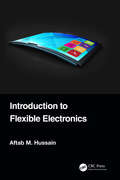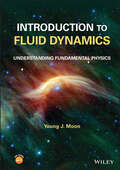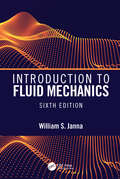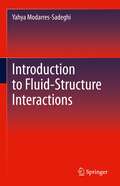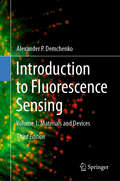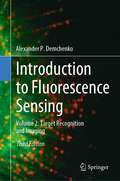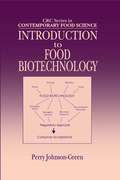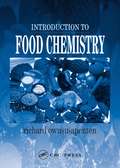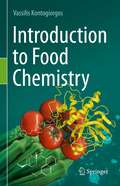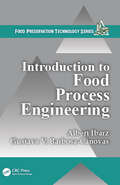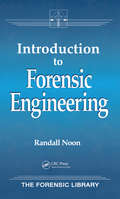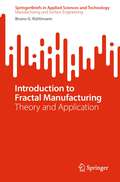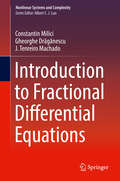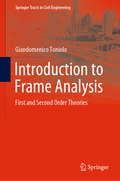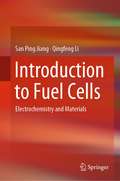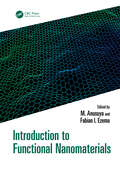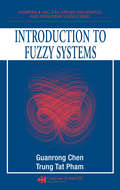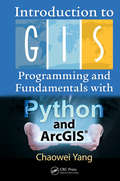- Table View
- List View
Introduction to Flat Panel Displays (Wiley Series in Display Technology #20)
by Shin-Tson Wu Jiun-Haw Lee I-Chun Cheng Hong HuaIntroduction to Flat Panel Displays describes the fundamental physics and materials of major flat panel display technologies including LED, OLED, LCD, PDP and FED and reflective displays. A reference for graduate students and new entrants to the display industry, the book currently covers the basic science behind each display technology and gives solved problems and homework problems in each chapter to aid self-study. With advancements in this field, there is enough change in the FPD industry to justify a second edition. This book offers the latest information on modern display technology and features new developments in OLED materials including phosphorescent, TTA, and TADF OLEDS, white light OLED and light extraction. It provides key information on blue phase, automotive lighting, quantum-dot enhanced LCDS, device configurations and performance, and LEDs, specifically nitrate-based. Application features include OLED for mobile, TV, light and flexible OLED, and reflective display specifically e-paper technology and low power consumption displays.
Introduction to Flexible Electronics
by Aftab M. HussainThe field of flexible electronics has grown rapidly over the last two decades with diverse applications including wearable gadgets and medical equipment. This textbook comprehensively covers the fundamental aspects of flexible electronics along with materials and processing techniques. It discusses topics including flexural rigidity, flexible PCBs, organic semiconductors, nanostructured materials, material reliability, electronic reliability, crystalline and polymer materials, semiconductor processing, and flexible silicon in depth. The text covers advantages, disadvantages, and applications of processes such as sol-gel processing and ink-jet printing. Pedagogical features such as solved problems and unsolved exercises are interspersed throughout the text for better understanding. FEATURES Covers major areas such as materials, physics, processes, and applications of flexible electronics Contains homework problems for readers to understand concepts in an easy manner Discusses, in detail, various types of materials, such as flexible silicon, metal oxides, and organic semiconductors Explains the application of flexible electronics in displays, solar cells, and batteries Includes a section on stretchable electronics This textbook is primarily written for senior undergraduate and graduate students in electrical engineering, electronics, materials science, chemistry, and communication engineering for a course on flexible electronics. Teaching resources are available, including a solutions manual for instructors.
Introduction to Flight Testing (Aerospace Series)
by James W. Gregory Tianshu LiuIntroduction to Flight Testing Introduction to Flight Testing Provides an introduction to the basic flight testing methods employed on general aviation aircraft and unmanned aerial vehicles Introduction to Flight Testing provides a concise introduction to the basic flight testing methods employed on general aviation aircraft and unmanned aerial vehicles for courses in aeronautical engineering. There is particular emphasis on the use of modern on-board instruments and inexpensive, off-the-shelf portable devices that make flight testing accessible to nearly any student. This text presents a clear articulation of standard methods for measuring aircraft performance characteristics. Topics covered include aircraft and instruments, digital data acquisition techniques, flight test planning, the standard atmosphere, uncertainty analysis, level flight performance, airspeed calibration, stall, climb and glide, take-off and landing, level turn, static and dynamic longitudinal stability, lateral-directional stability, and flight testing of unmanned aircraft systems. Unique to this book is a detailed discussion of digital data acquisition (DAQ) techniques, which are an integral part of modern flight test programs. This treatment includes discussion of the analog-to-digital conversion, sample rate, aliasing, and filtering. These critical details provide the flight test engineer with the insight needed to understand the capabilities and limitations of digital DAQ. Key features: Provides an introduction to the basic flight testing methods and instrumentation employed on general aviation aircraft and unmanned aerial vehicles. Includes examples of flight testing on general aviation aircraft such as Cirrus, Diamond, and Cessna aircraft, along with unmanned aircraft vehicles. Suitable for courses on Aircraft Flight Test Engineering. Introduction to Flight Testing provides resources and guidance for practitioners in the rapidly-developing field of drone performance flight test and the general aviation flight test community.
Introduction to Fluid Dynamics
by Edward B. Mcleod Jr.Concise, unified, and logical, this introduction to the study of the basic principles of fluid dynamics emphasizes the statement of problems in mathematical language. In addition to its value as a reference for professional engineers, this volume is suitable for advanced undergraduates and graduate students of mathematics and engineering. Some familiarity with the algebra of vector fields is assumed, and a useful appendix provides a succinct review of vector algebra.An introductory chapter covers fundamental notions from the continuum hypothesis to steady-state flow. Succeeding chapters explore conservation of mass, forces acting on a fluid in equilibrium, dynamic equations of motion, irrotational motion, integration of Euler's equation in special cases, and flows representable by harmonic functions. Additional topics include two dimensional flows, rectilinear vortices, general vortex motion, flows with a free boundary, and compressible fluids.
Introduction to Fluid Dynamics: Understanding Fundamental Physics
by Young J. MoonINTRODUCTION TO FLUID DYNAMICS A concise resource that presents a physics-based introduction to fluid dynamics and helps students bridge the gap between mathematical theory and real-world physical properties Introduction to Fluid Dynamics offers a unique physics-based approach to fluid dynamics. Instead of emphasizing specific problem-solving methodologies, this book explains and interprets the physics behind the theory, which helps mathematically-inclined students develop physical intuition while giving more physically-inclined students a better grasp of the underlying mathematics. Real-world examples and end-of-chapter practice problems are included to further enhance student understanding. Written by a highly-qualified author and experienced educator, topics are covered in a progressive manner, enabling maximum reader comprehension from start to finish. Sample topics covered in the book include: How forces originate in fluids How to define pressure in a fluid in motion How to apply conservation laws to deformable substances How viscous stresses are related to strain rates How centrifugal forces and viscosity play a role in curved motions and vortex dynamics How vortices and centrifugal forces are related in external viscous flows How energy is viscously dissipated in internal viscous flows How compressibility is related to wave and wave speed Students and instructors in advanced undergraduate or graduate fluid dynamics courses will find immense value in this concise yet comprehensive resource. It enables readers to easily understand complex fluid phenomena, regardless of the academic background they come from.
Introduction to Fluid Mechanics, Sixth Edition
by William S. JannaIntroduction to Fluid Mechanics, Sixth Edition, is intended to be used in a first course in Fluid Mechanics, taken by a range of engineering majors. The text begins with dimensions, units, and fluid properties, and continues with derivations of key equations used in the control-volume approach. Step-by-step examples focus on everyday situations, and applications. These include flow with friction through pipes and tubes, flow past various two and three dimensional objects, open channel flow, compressible flow, turbomachinery and experimental methods. Design projects give readers a sense of what they will encounter in industry. A solutions manual and figure slides are available for instructors.
Introduction to Fluid-Structure Interactions
by Yahya Modarres-SadeghiThis timely book introduces the subject of Fluid-Structure Interactions (FSI) to students and professionals. It discusses the major ideas in FSI with the goal of providing the fundamental understanding to the readers who possess limited or no understanding of the subject. The author presents the physics of the problem, rather than focusing on the methods, and discusses the essential methods of analysis. The principle goal of Introduction to Fluid-Structure Interactions is impart to students and practitioner a physical understanding of major topics in fluid-structure interactions: axial flow problems (when the direction of the flow is parallel to the long axis of the structure) and crossflow problems (when the direction of the flow is normal to the long axis of the structure). Facilitating readers’ understanding of both categories, starting with simple 1 DOF systems and continuing to more complicated continuous flexible structures, Introduction to Fluid-Structure Interactions, is ideal for graduate students and practitioners interested in this critical field.Stands as a unique introductory volume to study Fluid-Structure Interactions (FSI);Covers aspects of FSI relevant to Fluid Mechanics, Wind Energy, Ocean Engineering, and Biomedical research;Integrates most recent findings from research on FSI;Emphasizes the physics behind the phenomena in detail;Maximizes readers understanding by beginning with fundamental concepts and developing focus to more complex systems.
Introduction to Fluorescence Sensing: Volume 1: Materials and Devices
by Alexander P. DemchenkoThis book provides systematic knowledge of basic principles in the design of fluorescence sensing and imaging techniques together with critical analysis of recent developments. Fluorescence is the most popular technique in chemical and biological sensing because of its ultimate sensitivity, high temporal and spatial resolution and versatility that enables imaging within the living cells. It develops rapidly in the directions of constructing new molecular recognition units, new fluorescence reporters and in improving sensitivity of response up to detection of single molecules. Its application areas range from control of industrial processes to environment monitoring and clinical diagnostics. Being a guide for students and young researchers, it also addresses professionals involved in active basic and applied research. Making a strong link between education, research and product development, this book discusses prospects for future progress.
Introduction to Fluorescence Sensing: Volume 2: Target Recognition and Imaging
by Alexander P. DemchenkoFluorescence is the most popular technique in chemical and biological sensing because of its ultimate sensitivity, high temporal and spatial resolution and versatility that enables imaging within the living cells. It develops rapidly in the directions of constructing new molecular recognition units, new fluorescence reporters and in improving sensitivity of response up to detection of single molecules. Its application areas range from control of industrial processes to environment monitoring and clinical diagnostics. This book provides systematic knowledge of basic principles in design of fluorescence sensing and imaging techniques together with critical analysis of recent developments. Being a guide for students and young researchers, it also addresses professionals involved in active basic and applied research. Making a strong link between education, research and product development, this book discusses prospects for future progress.
Introduction to Food Biotechnology (Contemporary Food Science)
by Perry Johnson-GreenUniversities throughout the US and the rest of the world offer Food Biotechnology courses. However, until now, professors lacked a single, comprehensive text to present to their students. Introduction to Food Biotechnology describes, explains, and discusses biotechnology within the context of human nutrition, food production, and food processing. Written for undergraduate students in Food Science and Nutrition who do not have a background in molecular biology, it provides clear explanations of the broad range of topics that comprise the field of food biotechnology. Students will gain an understanding of the methods and rationales behind the genetic modification of plants and animals, as well as an appreciation of the associated risks to the environment and to public health. Introduction to Food Biotechnology examines cell culture, transgenic organisms, regulatory policy, safety issues, and consumer concerns. It covers microbial biotechnology in depth, emphasizing applications to the food industry and methods of large-scale cultivation of microbes and other cells. It also explores the potential of biotechnology to affect food security, risks, and other ethical problems.Biotechnology can be used as a tool within many disciplines, including food science, nutrition, dietetics, and agriculture. Using numerous examples, Introduction to Food Biotechnology lays a solid foundation in all areas of food biotechnology and provides a comprehensive review of the biological and chemical concepts that are important in each discipline. The book develops an understanding of the potential contributions of food biotechnology to the food industry, and towards improved food safety and public health.
Introduction to Food Chemistry
by Richard Owusu-ApentenProviding a thorough introduction to the core areas of food science specified by the Institute of Food Technologists, Introduction to Food Chemistry focuses on principles rather than commodities and balances facts with explanations. The text covers the major areas of food science, including food chemistry, food analysis and methods for quality assu
Introduction to Food Chemistry
by Vassilis KontogiorgosThe complexity of food chemistry makes it a challenging subject for students studying in a food science course. Although there are excellent food chemistry books available in the market they have two major flaws: they are either encyclopedic or they are not pitched correctly to undergraduate food science students. The first problem creates difficulties for students to identify what is important and how much they need to know. The second problem arises when the book is written by authors that are not food scientists (e.g., chemists), they are not academics that are engaged with teaching or they are not sufficiently qualified to teach. In this case, it is difficult to find links between the chemistry of foods and its relevance to applications or, quite frequently, future employment prospects of the student. Introduction to Food Chemistry bridges this gap in the relevant literature, as it employs the latest pedagogical theories in textbook writing to present the subject to students with broad range of cognitive skills. This book presents specific learning objectives for each chapter and is self-contained so students will not need to search for essential information outside the textbook. To support learning, the book has:Didactic elements with information being conveyed with 3D-figures, color-coded schemes and graphs, annotations on figures that link it to the text descriptionsBuilt-in pedagogy and learning activities at the end of each chapter that are linked to the learning objectives.Keywords and concepts for online search to instigate curiosity for further studies.Conversational writing style without losing academic rigorTo support lecturers, the book has:Helps focus teaching preparation on key aspects of food chemistry relevant to both industry and modern research.Aids the preparation of exams, assignments and other types of assessment or learning activities.For lecturers in search of a singular source to aid in their introductory food chemistry courses, look no further than Introduction to Food Chemistry.
Introduction to Food Chemistry
by Vassilis KontogiorgosThe complexity of food chemistry makes it a challenging subject for students studying in a food science course. Although there are excellent food chemistry books available in the market they have two major flaws: they are either encyclopedic or they are not pitched correctly to undergraduate food science students. The first problem creates difficulties for students to identify what is important and how much they need to know. The second problem arises when the book is written by authors that are not food scientists (e.g., chemists), they are not academics that are engaged with teaching or they are not sufficiently qualified to teach. In this case, it is difficult to find links between the chemistry of foods and its relevance to applications or, quite frequently, future employment prospects of the student. Introduction to Food Chemistry, 2nd Edition bridges this gap in the relevant literature, as it employs the latest pedagogical theories in textbook writing to present the subject to students with broad range of cognitive skills. This book presents specific learning objectives for each chapter and is self-contained so students will not need to search for essential information outside the textbook. This new edition has been expanded to include chapters on sweeteners, glass transition, amino acids, proteins for major food commodities and food additives. All of the original chapters have been updated and expanded to include new research and technologies. To support learning, the book has:Didactic elements with information being conveyed with 3D-figures, color-coded schemes and graphs, annotations on figures that link it to the text descriptionsBuilt-in pedagogy and learning activities at the end of each chapter that are linked to the learning objectives.Keywords and concepts for online search to instigate curiosity for further studies.Conversational writing style without losing academic rigorTo support lecturers, the book has:Helps focus teaching preparation on key aspects of food chemistry relevant to both industry and modern research.Aids the preparation of exams, assignments and other types of assessment or learning activities.For lecturers in search of a singular source to aid in their introductory food chemistry courses, look no further than this expanded new edition of Introduction to Food Chemistry.
Introduction to Food Process Engineering
by P. G. SmithThis is a new book on food process engineering which treats the principles of processing in a scientifically rigorous yet concise manner, and which can be used as a lead in to more specialized texts for higher study. It is equally relevant to those in the food industry who desire a greater understanding of the principles of the food processes with which they work. This text is written from a quantitative and mathematical perspective and is not simply a descriptive treatment of food processing. The aim is to give readers the confidence to use mathematical and quantitative analyses of food processes and most importantly there are a large number of worked examples and problems with solutions. The mathematics necessary to read this book is limited to elementary differential and integral calculus and the simplest kind of differential equation.
Introduction to Food Process Engineering (Food Preservation Technology)
by Albert Ibarz Gustavo V. Barbosa-CanovasConsumer expectations are systematically growing, with demands for foods with a number of attributes, which are sometimes difficult for manufacturers to meet. The engineering processes that are needed to obtain top-quality foods are a major challenge due to the diversity of raw materials, intermediates, and final products. As in any other enterpris
Introduction to Forensic Engineering (Forensics Library)
by Randall K. NoonForensic engineering is generally defined as the application of engineering principles and methodology to answer questions of fact that may have legal ramifications. This new book provides an introduction to the science, methodology, and engineering principles involved in the diagnosis of some common types of accidents and failures, such as fires, explosions, automobile accidents, storm damage, industrial accidents, slips and falls, arson, water pipe damage and more. Each chapter stands alone and can be read without reference to the others. The chapters have been written so that non-technical professionals can easily digest the information and immediately apply it. The book will also be useful to technical professionals who are unfamiliar with particular investigative methodology or technical points of interest. Introduction to Forensic Engineering will benefit lawyers, insurance investigators, engineers, and other professionals who must handle investigative and legal aspects of accidents or failures.
Introduction to Fractal Manufacturing: Theory and Application (SpringerBriefs in Applied Sciences and Technology)
by Bruno G. RüttimannThis book offers a comprehensive exploration of a new manufacturing mode designed to revolutionize the reliability of interdependent networks. It provides the necessary theoretical foundation and practical implementation guidance for Fractal Manufacturing with Variable Quantum Flow, an innovative manufacturing approach tailored to reduce process lead time (PLT) and to meet the demands of value chains reliant on 100% on-time delivery (OTD). The book introduces readers to introductory concepts, delves into the evolution from the BCT Deviation Function to Fractal Manufacturing, characterizes the Fractal Manufacturing system, and explores additional aspects beyond its modeling. With a focus on non-deterministic business environments and make-to-order productions, this book presents a pushed JIT system that is poised to transform manufacturing practices
Introduction to Fractional Differential Equations (Nonlinear Systems And Complexity Ser. #25)
by Constantin Milici Gheorghe Drăgănescu J. Tenreiro MachadoThis book introduces a series of problems and methods insufficiently discussed in the field of Fractional Calculus – a major, emerging tool relevant to all areas of scientific inquiry. The authors present examples based on symbolic computation, written in Maple and Mathematica, and address both mathematical and computational areas in the context of mathematical modeling and the generalization of classical integer-order methods. Distinct from most books, the present volume fills the gap between mathematics and computer fields, and the transition from integer- to fractional-order methods.
Introduction to Frame Analysis: First and Second Order Theories (Springer Tracts in Civil Engineering)
by Giandomenico TonioloThis textbook presents the principal methods of stress analysis for the design of frame structures, beginning with a description of the basic criteria for probabilistic safety verification used in modern codes. The Force Method and the Displacement Method are dealt with, together with their applications to more common structural situations. A special chapter is dedicated to the second order analysis required for slender structures and for the elaboration of instability problems. In turn, a thorough set of numerical examples rounds out the text. Given its scope, the book offers an ideal learning resource for students of Civil and Building Engineering and Architecture, and a valuable reference guide for practicing structural design professionals.
Introduction to Fuel Cells: Electrochemistry and Materials
by San Ping Jiang Qingfeng LiThis textbook covers essential electrochemistry and materials science content and provides an extensive collection of examples in order to bridge the gap between engineering students’ basic knowledge and the concrete skills they need to handle practical problems in fuel cells. The book starts with an introduction to the basic thermodynamics and electrochemistry principles and techniques in fuel cells. It subsequently discusses fuel cell operation principles, electrocatalysts, electrode materials, cell and system configuration and technologies in low-temperature fuel cells such as alkaline fuel cells and proton exchange membrane fuel cells, and in high-temperature fuel cells including solid oxide and molten carbonate fuel cells. Other energy conversion and storage technologies such as supercapacitors, batteries and electrolysis are also covered. A special chapter on laboratory experiments with fuel cells is also included, which can be conducted in conjunction with classroom teaching. Each chapter includes problems and exercises.The book provides students with an engineering background essential information on the basic thermodynamics, electrochemistry and materials of fuel cells, the most efficient and environmentally friend energy conversion technologies, all in a single book.
Introduction to Functional Nanomaterials
by Fabian I. Ezema M. AnusuyaThis book provides a comprehensive review of nanomaterials, including essential foundational examples of nanosensors, smart nanomaterials, nanopolymers, and nanotubes. Chapters cover their synthesis and characteristics, production methods, and applications, with specific sections exploring nanoelectronics and electro-optic nanotechnology, nanostructures, and nanodevices. This book is a valuable resource for interdisciplinary researchers who want to learn more about the synthesis of nanomaterials and how they are used in different types of energy storage devices, including supercapacitors, batteries, fuel cells solar cells in addition to electrical, chemical, and biomedical engineering.Key Features: Comprehensive overview of how nanomaterials can be utilised in a variety of interdisciplinary applications Explores the fundamental theories, alongside their electrochemical mechanisms and computation Discusses recent developments in electrode designing based on nanomaterials, separators, and the fabrication of advanced devices and their performances
Introduction to Fuzzy Logic
by James K. PeckolINTRODUCTION TO FUZZY LOGIC Learn more about the history, foundations, and applications of fuzzy logic in this comprehensive resource by an academic leader Introduction to Fuzzy Logic delivers a high-level but accessible introduction to the rapidly growing and evolving field of fuzzy logic and its applications. Distinguished engineer, academic, and author James K. Peckol covers a wide variety of practical topics, including the differences between crisp and fuzzy logic, the people and professionals who find fuzzy logic useful, and the advantages of using fuzzy logic. While the book assumes a solid foundation in embedded systems, including basic logic design, and C/C++ programming, it is written in a practical and easy-to-read style that engages the reader and assists in learning and retention. The author includes introductions of threshold and perceptron logic to further enhance the applicability of the material contained within. After introducing readers to the topic with a brief description of the history and development of the field, Introduction to Fuzzy Logic goes on to discuss a wide variety of foundational and advanced topics, like: A review of Boolean algebra, including logic minimization with algebraic means and Karnaugh maps A discussion of crisp sets, including classic set membership, set theory and operations, and basic classical crisp set properties A discussion of fuzzy sets, including the foundations of fuzzy set logic, set membership functions, and fuzzy set properties An analysis of fuzzy inference and approximate reasoning, along with the concepts of containment and entailment and relations between fuzzy subsets Perfect for mid-level and upper-level undergraduate and graduate students in electrical, mechanical, and computer engineering courses, Introduction to Fuzzy Logic covers topics included in many artificial intelligence, computational intelligence, and soft computing courses. Math students and professionals in a wide variety of fields will also significantly benefit from the material covered in this book.
Introduction to Fuzzy Systems (Chapman & Hall/CRC Applied Mathematics & Nonlinear Science)
by Guanrong Chen Trung Tat PhamIntroduction to Fuzzy Systems provides students with a self-contained introduction that requires no preliminary knowledge of fuzzy mathematics and fuzzy control systems theory. Simplified and readily accessible, it encourages both classroom and self-directed learners to build a solid foundation in fuzzy systems. To keep pace with and further advance the rapidly developing field of applied control technologies, this book provides systematic training in the analytic theory and rigorous design of fuzzy systems. Almost entirely self-contained, it establishes a brief, yet sufficient foundation for designing and analyzing fuzzy intelligent and control systems. It clearly explains fuzzy sets, fuzzy logic, fuzzy inference, approximate reasoning, fuzzy rule base, basic fuzzy PID control systems, and more. This outstanding text includes teaching examples as well as problem exercises, and it can easily be used as a classroom text or tutorial for self-study that will prepare readers for further work in the field.
Introduction to GIS Programming and Fundamentals with Python and ArcGIS®
by Chaowei YangCombining GIS concepts and fundamental spatial thinking methodology with real programming examples, this book introduces popular Python-based tools and their application to solving real-world problems. It elucidates the programming constructs of Python with its high-level toolkits and demonstrates its integration with ArcGIS Theory. Filled with hands-on computer exercises in a logical learning workflow this book promotes increased interactivity between instructors and students while also benefiting professionals in the field with vital knowledge to sharpen their programming skills. Readers receive expert guidance on modules, package management, and handling shapefile formats needed to build their own mini-GIS. Comprehensive and engaging commentary, robust contents, accompanying datasets, and classroom-tested exercises are all housed here to permit users to become competitive in the GIS/IT job market and industry.
Introduction to GNSS Geodesy: Foundations of Precise Positioning Using Global Navigation Satellite Systems
by Clement A. OgajaIntroduction to GNSS Geodesy is a concise reference for beginners and experts in GNSS-based satellite geodesy. It covers all of the important concepts in almost a third of the space of the other GNSS books. Th e book begins with a case study in Augmented Reality to set the stage for what is to come and then moves on to the key elements of GNSS geodesy that make accurate and precise geopositioning possible. For example, it is important to understand the geodetic reference systems and the associated GNSS data processing strategies that enable both accurate and high-precision geopositioning. Chapter 2 gives an overview of GNSS constellations and signals, highlighting important characteristics. Chapter 3 then introduces reference systems in geodesy, covering such topics as time systems, geodetic datums, coordinate systems, coordinate conversions and transformations, and International Terrestrial Reference Frame. Th is lays the framework for the rest of the book. Chapters 4 and 5 dig deep into mathematical formulation of GNSS parameter estimation and observation models. All the concepts are presented clearly and concisely, with diagrams to assist reader comprehension. Chapter 6 describes Continuously Operating Reference Station (CORS) networks and their role in geodesy and definition of reference frames. Various global and regional CORS networks are presented in this section. Th e chapter also covers GNSS data and common formats such as RINEX and RTCM. Chapter 7 introduces the whole cycle of GNSS data processing, including preprocessing, ambiguity fixing, and solution reprocessing methods as commonly used in both epoch solutions and time series data. Th e book concludes with appendices on orbit modelling, GNSS linear combinations, application examples, and an example linear model.
